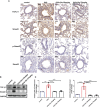Sinomenine Relieves Airway Remodeling By Inhibiting Epithelial-Mesenchymal Transition Through Downregulating TGF-β1 and Smad3 Expression In Vitro and In Vivo
- PMID: 34804018
- PMCID: PMC8602849
- DOI: 10.3389/fimmu.2021.736479
Sinomenine Relieves Airway Remodeling By Inhibiting Epithelial-Mesenchymal Transition Through Downregulating TGF-β1 and Smad3 Expression In Vitro and In Vivo
Abstract
Airway remodeling is associated with dysregulation of epithelial-mesenchymal transition (EMT) in patients with asthma. Sinomenine (Sin) is an effective, biologically active alkaloid that has been reported to suppress airway remodeling in mice with asthma. However, the molecular mechanisms behind this effect remain unclear. We aimed to explore the potential relationship between Sin and EMT in respiratory epithelial cells in vitro and in vivo. First, 16HBE cells were exposed to 100 μg/mL LPS and treated with 200 μg/mL Sin. Cell proliferation, migration, and wound healing assays were performed to evaluate EMT, and EMT-related markers were detected using Western blotting. Mice with OVA-induced asthma were administered 35 mg/kg or 75 mg/kg Sin. Airway inflammation and remodeling detection experiments were performed, and EMT-related factors and proteins in the TGF-β1 pathway were detected using IHC and Western blotting. We found that Sin suppressed cell migration but not proliferation in LPS-exposed 16HBE cells. Sin also inhibited MMP7, MMP9, and vimentin expression in 16HBE cells and respiratory epithelial cells from mice with asthma. Furthermore, it decreased OVA-specific IgE and IL-4 levels in serum, relieved airway remodeling, attenuated subepithelial collagen deposition, and downregulating TGF-β1and Smad3 expression in mice with asthma. Our results suggest that Sin suppresses EMT by inhibiting IL-4 and downregulating TGF-β1 and Smad3 expression.
Keywords: EMT; Sinomenine; TGF-β1/Smad3 expression; airway remodeling; asthma.
Copyright © 2021 He, Cao, Wang, Wang, Miao, Li and Miao.
Conflict of interest statement
The authors declare that the research was conducted in the absence of any commercial or financial relationships that could be construed as a potential conflict of interest.
Figures






Similar articles
-
Scutellarin Alleviates Ovalbumin-Induced Airway Remodeling in Mice and TGF-β-Induced Pro-fibrotic Phenotype in Human Bronchial Epithelial Cells via MAPK and Smad2/3 Signaling Pathways.Inflammation. 2024 Jun;47(3):853-873. doi: 10.1007/s10753-023-01947-7. Epub 2024 Jan 2. Inflammation. 2024. PMID: 38168709 Free PMC article.
-
Huangqi-Fangfeng protects against allergic airway remodeling through inhibiting epithelial-mesenchymal transition process in mice via regulating epithelial derived TGF-β1.Phytomedicine. 2019 Nov;64:153076. doi: 10.1016/j.phymed.2019.153076. Epub 2019 Aug 23. Phytomedicine. 2019. PMID: 31473579
-
Atrial natriuretic peptide inhibits epithelial-mesenchymal transition (EMT) of bronchial epithelial cells through cGMP/PKG signaling by targeting Smad3 in a murine model of allergic asthma.Exp Lung Res. 2019 Oct;45(8):245-254. doi: 10.1080/01902148.2019.1660734. Epub 2019 Sep 9. Exp Lung Res. 2019. PMID: 31496319
-
[Advances in pathogenesis of asthma airway remodeling and intervention mechanism of traditional Chinese medicine].Zhongguo Zhong Yao Za Zhi. 2025 Apr;50(8):2050-2070. doi: 10.19540/j.cnki.cjcmm.20241212.705. Zhongguo Zhong Yao Za Zhi. 2025. PMID: 40461218 Review. Chinese.
-
Epithelial-mesenchymal transition in asthma: its role and underlying regulatory mechanisms.Front Immunol. 2025 Jan 22;16:1519998. doi: 10.3389/fimmu.2025.1519998. eCollection 2025. Front Immunol. 2025. PMID: 39911398 Free PMC article. Review.
Cited by
-
Feasibility analysis of Sinomenine alleviating fibrosis of filtering bleb after glaucoma filtering surgery: a mini review.Front Med (Lausanne). 2025 Jul 8;12:1607500. doi: 10.3389/fmed.2025.1607500. eCollection 2025. Front Med (Lausanne). 2025. PMID: 40697912 Free PMC article. Review.
-
Scutellarin Alleviates Ovalbumin-Induced Airway Remodeling in Mice and TGF-β-Induced Pro-fibrotic Phenotype in Human Bronchial Epithelial Cells via MAPK and Smad2/3 Signaling Pathways.Inflammation. 2024 Jun;47(3):853-873. doi: 10.1007/s10753-023-01947-7. Epub 2024 Jan 2. Inflammation. 2024. PMID: 38168709 Free PMC article.
-
The Role and Mechanisms of Traditional Chinese Medicine for Airway Inflammation and Remodeling in Asthma: Overview and Progress.Front Pharmacol. 2022 Jul 15;13:917256. doi: 10.3389/fphar.2022.917256. eCollection 2022. Front Pharmacol. 2022. PMID: 35910345 Free PMC article. Review.
-
High expression of ITGB3 ameliorates asthma by inhibiting epithelial-mesenchymal transformation through suppressing the activation of NF-kB pathway.Sci Rep. 2025 Apr 22;15(1):13837. doi: 10.1038/s41598-025-98842-y. Sci Rep. 2025. PMID: 40263524 Free PMC article.
-
Modulating TRPV1 and TRPA1 channels: a viable strategy for treating asthma using Chinese herbal medicines.Front Pharmacol. 2025 Jul 3;16:1573901. doi: 10.3389/fphar.2025.1573901. eCollection 2025. Front Pharmacol. 2025. PMID: 40678720 Free PMC article. Review.
References
Publication types
MeSH terms
Substances
LinkOut - more resources
Full Text Sources
Medical
Miscellaneous

